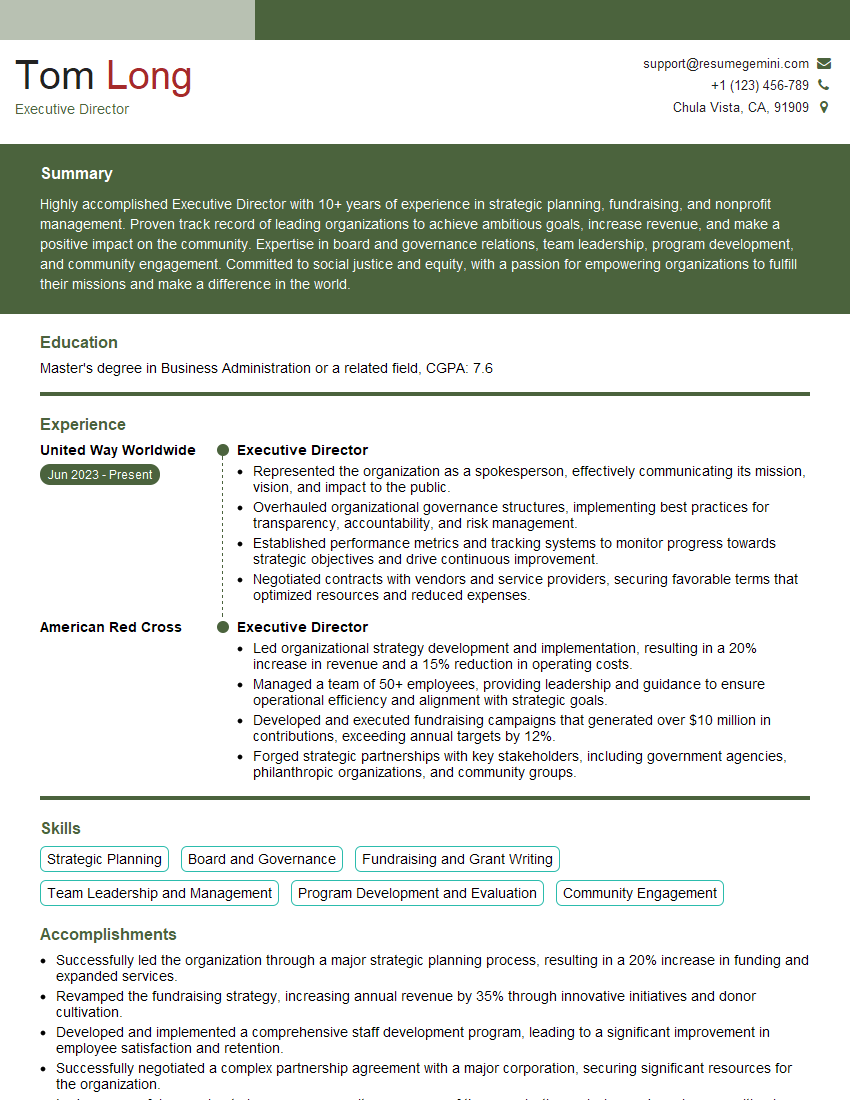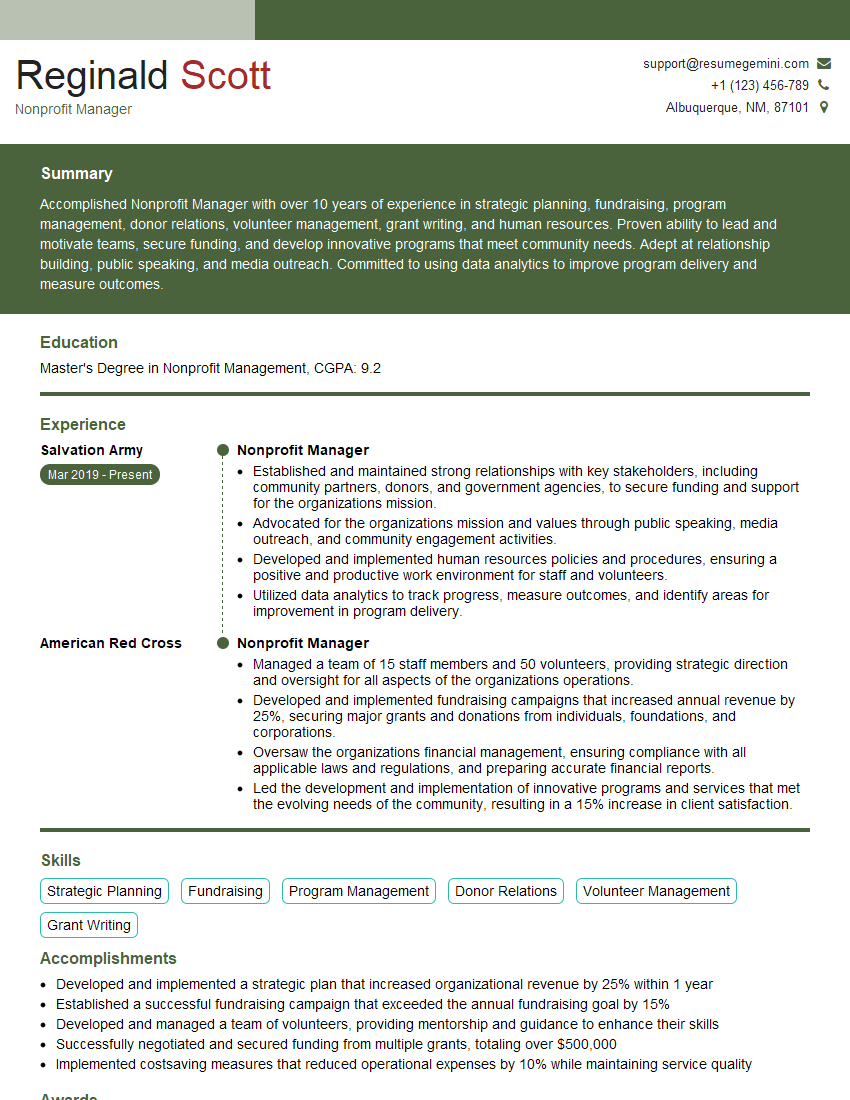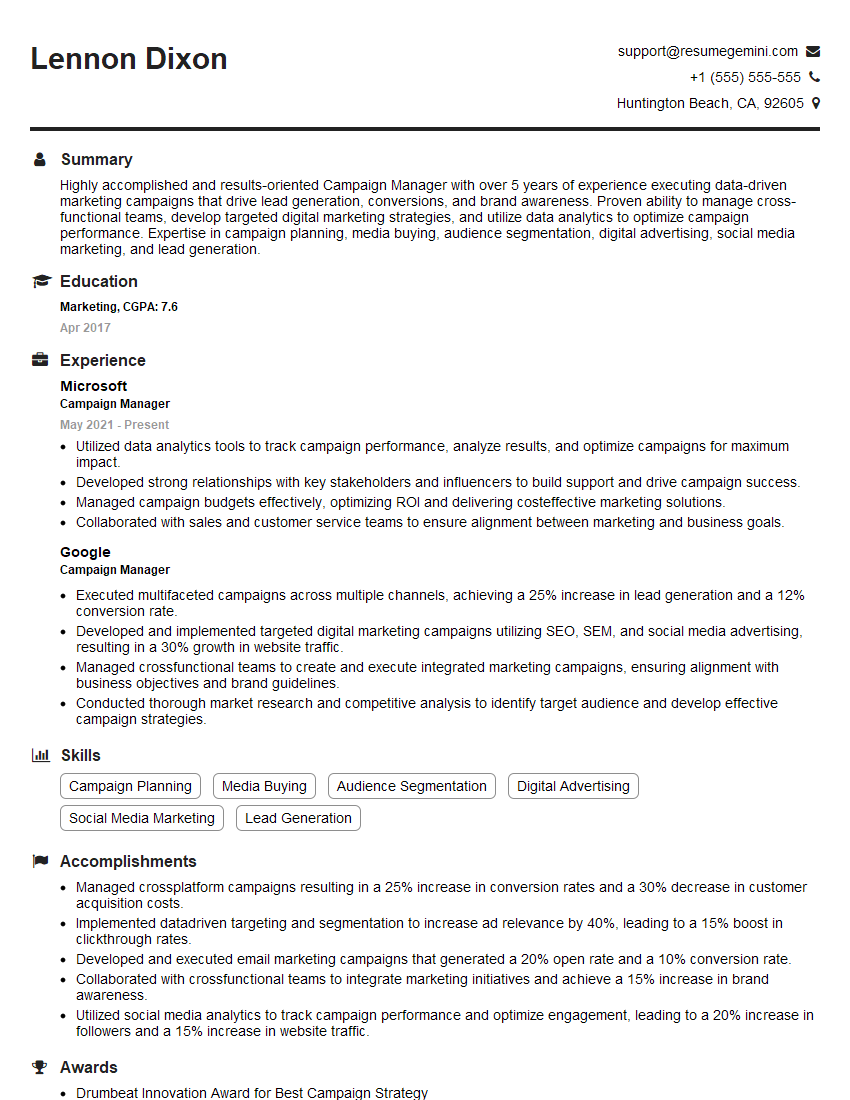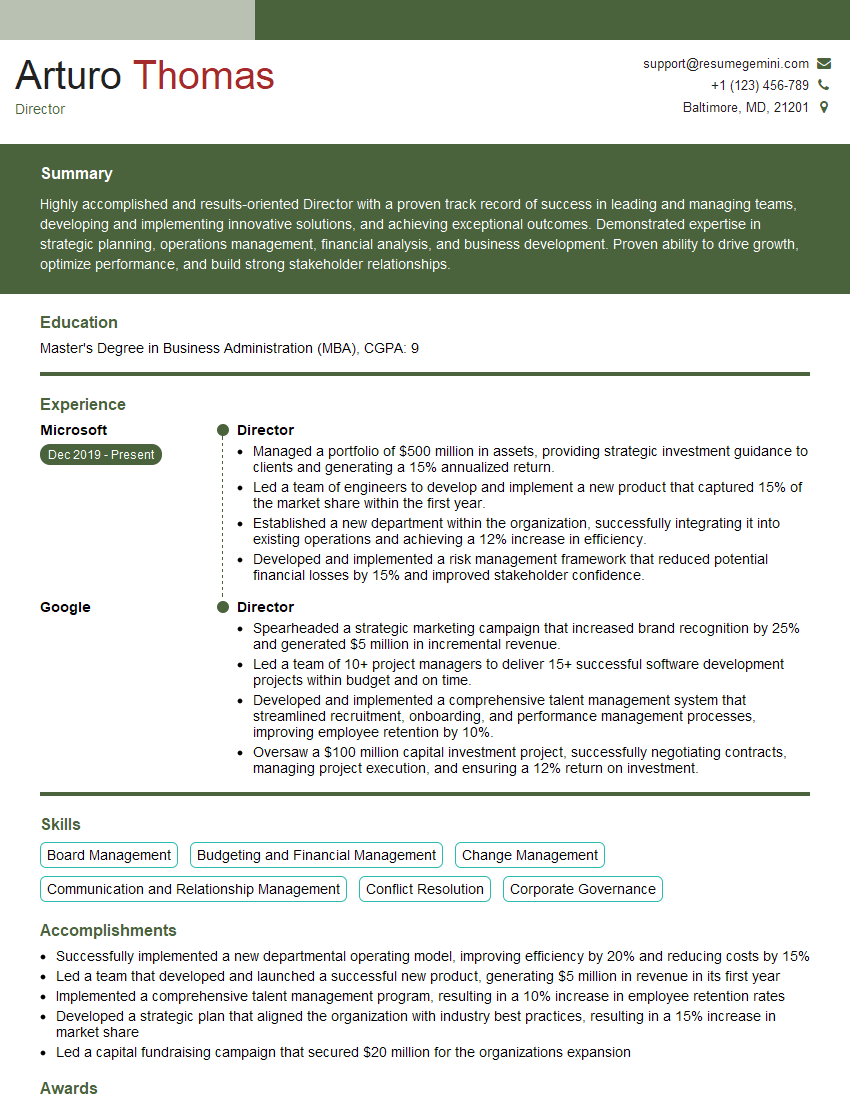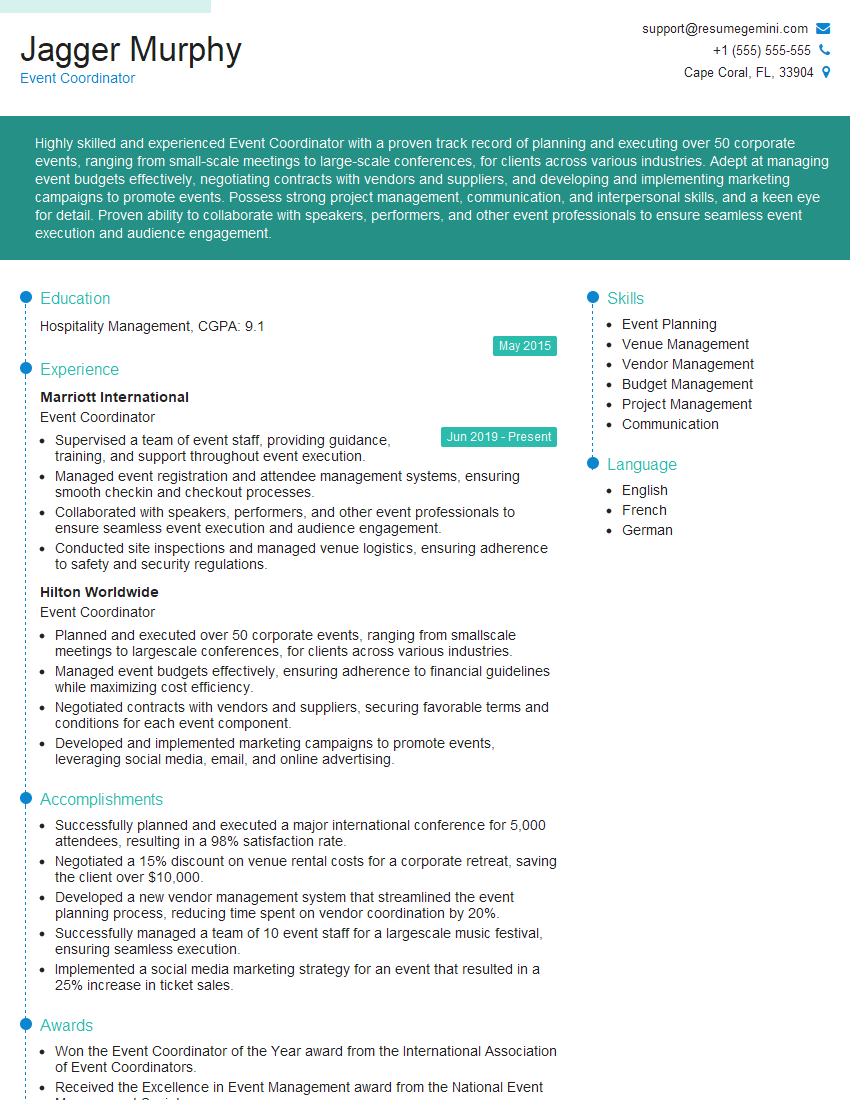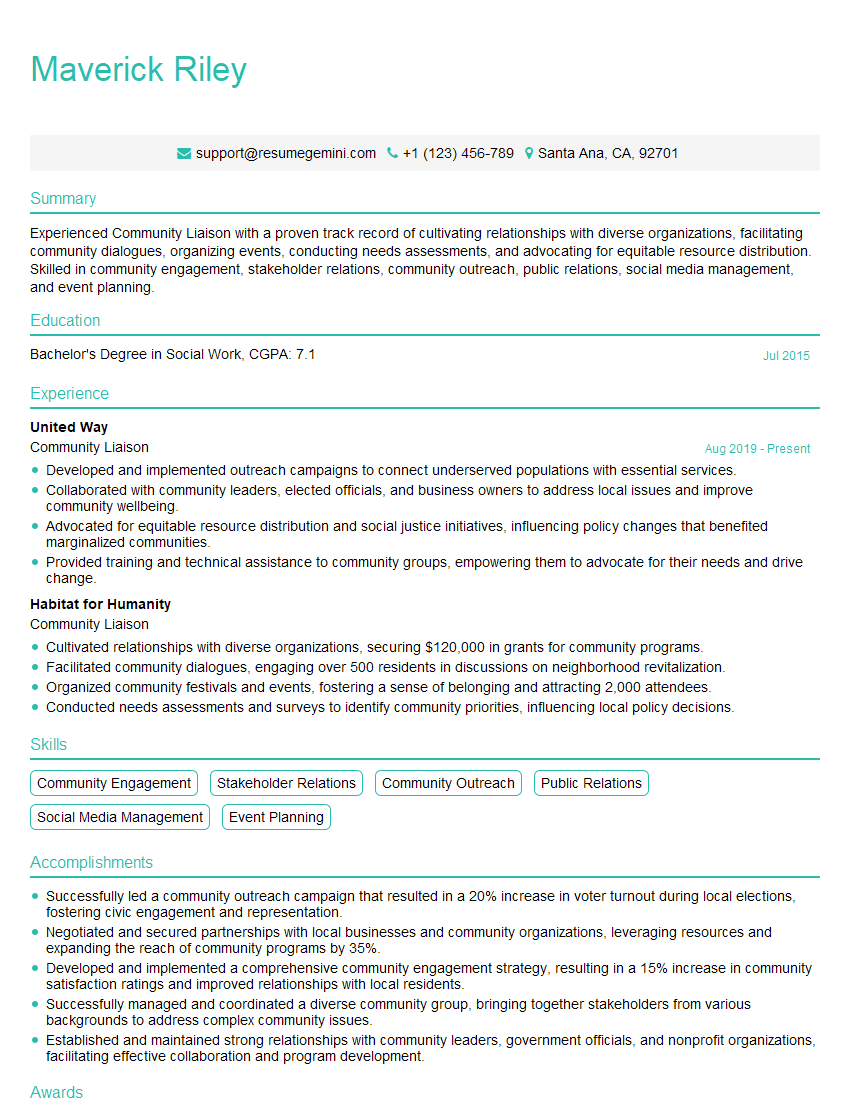Interviews are opportunities to demonstrate your expertise, and this guide is here to help you shine. Explore the essential Collaborating with Other Officials and Organizers interview questions that employers frequently ask, paired with strategies for crafting responses that set you apart from the competition.
Questions Asked in Collaborating with Other Officials and Organizers Interview
Q 1. Describe your experience building consensus among diverse stakeholders.
Building consensus among diverse stakeholders requires a multifaceted approach that prioritizes active listening, empathy, and strategic negotiation. It’s like orchestrating a symphony – each instrument (stakeholder) has its unique voice, and the conductor (you) needs to harmonize them to create beautiful music (a shared outcome).
- Understanding Perspectives: I begin by actively listening to each stakeholder’s concerns, needs, and perspectives. I ask open-ended questions to encourage them to articulate their viewpoints fully.
- Identifying Common Ground: After gathering diverse perspectives, I identify areas of agreement and shared goals. Highlighting these commonalities helps build a foundation for collaboration.
- Addressing Concerns: I directly address any concerns or objections, seeking to understand the root cause. This often involves compromising or finding creative solutions that accommodate various needs.
- Transparency and Communication: Maintaining open and transparent communication throughout the process is crucial. Regular updates, feedback sessions, and collaborative decision-making ensure everyone feels heard and valued.
- Iterative Process: Building consensus is rarely a linear process. I anticipate the need for adjustments and iterate based on feedback and emerging information.
For example, during a community development project, I had to bring together residents, businesses, and local government officials with vastly different priorities. Through a series of facilitated workshops and open forums, we were able to identify shared desires for improved infrastructure and economic growth, leading to a unified vision and successful project implementation.
Q 2. Explain your approach to resolving conflicts between different departments or teams.
Resolving conflicts between departments or teams requires a structured, impartial approach focused on understanding the underlying issues and finding mutually agreeable solutions. My approach is based on collaboration and communication, rather than confrontation.
- Define the Problem: Clearly articulate the nature of the conflict, avoiding blame or accusations. What are the specific points of disagreement?
- Gather Information: Gather information from all involved parties to gain a comprehensive understanding of the situation and perspectives.
- Facilitate Discussion: Create a safe space for open and honest communication, encouraging everyone to express their concerns without interruption. Use active listening to ensure all voices are heard.
- Identify Common Goals: Remind the conflicting parties of their shared objectives and how resolving the conflict contributes to the overall success of the project or organization.
- Brainstorm Solutions: Engage in collaborative brainstorming to generate a range of potential solutions. Consider compromises that address the needs of all parties.
- Implement and Monitor: Once a solution is agreed upon, implement it and closely monitor its effectiveness. Address any further issues that arise.
For instance, I once mediated a conflict between the marketing and sales departments over budget allocation. By facilitating a discussion and collaboratively analyzing sales data and marketing campaign effectiveness, we developed a revised budget that satisfied both departments’ needs and aligned with overall company goals.
Q 3. How do you manage competing priorities when collaborating with multiple officials?
Managing competing priorities when collaborating with multiple officials requires a strategic approach that involves prioritization, clear communication, and effective negotiation. Think of it as a skilled juggler – each ball represents a priority, and the juggler needs to keep all of them in the air without dropping any.
- Prioritization Matrix: I use a prioritization matrix (e.g., Eisenhower Matrix) to rank competing priorities based on urgency and importance. This helps me focus on the most critical tasks first.
- Resource Allocation: I carefully allocate resources (time, budget, personnel) to reflect the prioritized tasks. This ensures that efforts are focused on achieving the most impactful outcomes.
- Transparency and Communication: Keeping all officials informed about the prioritization process and rationale is crucial. This prevents misunderstandings and fosters trust.
- Negotiation and Compromise: When conflicts arise, I engage in constructive negotiation to find mutually acceptable solutions. This may involve adjusting timelines, shifting responsibilities, or compromising on certain aspects of the projects.
- Regular Review and Adjustment: The priorities may shift over time. I conduct regular reviews and make necessary adjustments to ensure alignment with changing circumstances.
Q 4. Give an example of a time you successfully negotiated a compromise to achieve a shared goal.
During a large-scale community event planning, the Parks and Recreation Department wanted a specific date that conflicted with the historical society’s annual fair. Both events were crucial to the community and generated significant revenue. Instead of forcing a decision, I facilitated a meeting involving representatives from both departments. Through discussion, we discovered a solution: a staggered scheduling – the fair would conclude early and the community event would begin later in the day, utilizing some overlapping resources and minimizing overlap.
This compromise allowed both events to proceed without direct conflict, maximizing community engagement and resource utilization. The successful negotiation demonstrated my ability to find creative solutions that satisfied multiple stakeholders and achieved a shared goal.
Q 5. How do you ensure clear communication and information flow when working on collaborative projects?
Ensuring clear communication and information flow is paramount in collaborative projects. This involves establishing clear channels, using appropriate tools, and fostering a culture of open dialogue.
- Establish Communication Protocols: Define clear communication channels (e.g., email, project management software, regular meetings) and expectations for response times.
- Utilize Collaboration Tools: Employ project management software (e.g., Asana, Trello) or shared document platforms (e.g., Google Docs) to facilitate information sharing and collaborative work.
- Regular Meetings and Updates: Schedule regular meetings to discuss progress, address challenges, and ensure alignment among team members and officials.
- Documentation and Record Keeping: Maintain detailed records of decisions, agreements, and action items. This creates a shared understanding and avoids future misunderstandings.
- Feedback Mechanisms: Establish mechanisms for regular feedback and suggestions from all stakeholders to promote transparency and ensure everyone feels heard.
Q 6. Describe a time you had to adapt your communication style to effectively work with different personalities.
Adapting communication style to different personalities is essential for effective collaboration. It’s about understanding individual communication preferences and tailoring your approach accordingly.
In one instance, I was working with a team that included a highly analytical data scientist and a highly creative marketing professional. The data scientist preferred detailed reports and evidence-based discussions, while the marketing professional thrived on brainstorming sessions and visual representations. To effectively communicate with both, I provided data-driven reports to the data scientist and presented the same information visually to the marketing professional. This tailored approach fostered better understanding and more productive collaboration.
Q 7. How do you handle disagreements or differing opinions among team members or officials?
Disagreements and differing opinions are inevitable in collaborative settings. My approach focuses on respectful dialogue, collaborative problem-solving, and finding common ground.
- Create a Safe Space: Establish a respectful and inclusive environment where individuals feel comfortable expressing their opinions without fear of judgment.
- Active Listening and Empathy: Actively listen to each perspective and try to understand the underlying reasons for disagreement.
- Focus on Shared Goals: Remind the team of their shared objectives and how resolving the disagreement will contribute to the overall goal.
- Collaborative Problem-Solving: Engage in collaborative problem-solving, brainstorming potential solutions that address everyone’s concerns.
- Mediation and Facilitation: If necessary, act as a mediator to facilitate a constructive dialogue and help find a mutually acceptable solution.
- Decision-Making Process: Establish a clear decision-making process that ensures fairness and transparency.
Q 8. How proficient are you in using collaborative tools (e.g., project management software)?
My proficiency with collaborative tools is extensive. I’m highly adept at utilizing project management software such as Asana, Trello, Monday.com, and Microsoft Project. Beyond these, I’m comfortable using communication platforms like Slack, Microsoft Teams, and Google Workspace for seamless collaboration. My skillset extends to utilizing these tools not just for task management, but for fostering communication, tracking progress, and managing documents efficiently. For example, in a recent project involving the organization of a large-scale conference, I leveraged Asana to assign tasks, set deadlines, and track the progress of various teams responsible for logistics, marketing, and speaker coordination. The visual dashboards provided clear insights into the project’s health, allowing for proactive issue resolution.
Q 9. Describe your experience in developing and implementing collaborative strategies.
Developing and implementing collaborative strategies involves a multi-faceted approach. It begins with clearly defining project goals and objectives, ensuring all stakeholders are aligned on the desired outcomes. This is followed by identifying key roles and responsibilities, establishing clear communication channels, and choosing the appropriate collaborative tools. For instance, in a past initiative focused on community outreach, I implemented a strategy that combined regular team meetings, a shared online document for brainstorming, and a dedicated Slack channel for quick updates and discussions. This hybrid approach proved extremely effective in fostering engagement and facilitating efficient decision-making. The result was a significantly successful community engagement program with improved communication and heightened participation across all groups.
Q 10. How do you track progress and measure success in collaborative projects?
Tracking progress and measuring success in collaborative projects relies on a combination of qualitative and quantitative data. Quantitative measures might involve tracking milestones achieved, tasks completed on time, and budget adherence. Qualitative data includes feedback gathered from stakeholders through surveys, interviews, or informal check-ins. For instance, in a project aimed at improving a city’s park system, we tracked the number of completed renovations, the increase in park usage (measured by foot traffic counters), and the positive feedback received through online surveys and community forums. This combination of data paints a comprehensive picture of success and identifies areas for improvement. Key Performance Indicators (KPIs) are crucial in this process, allowing for focused evaluation and adjustment.
Q 11. How do you delegate tasks effectively within a collaborative environment?
Effective delegation in a collaborative environment starts with a thorough understanding of team members’ strengths and weaknesses. Tasks should be assigned based on individual capabilities and aligned with their roles and responsibilities. Clear expectations, deadlines, and communication channels should be established upfront. Furthermore, providing regular feedback and support is vital for ensuring successful task completion. I avoid micromanagement and instead focus on providing guidance and fostering a sense of ownership among team members. For example, in a recent fundraising campaign, I delegated specific fundraising strategies to team members based on their expertise and experience, ensuring they had the resources and autonomy they needed to succeed.
Q 12. How do you ensure all stakeholders are informed and engaged throughout a collaborative process?
Keeping stakeholders informed and engaged is critical. This involves establishing regular communication channels (e.g., newsletters, regular meetings, project updates), using easily accessible platforms (e.g., shared online documents, project management software), and actively soliciting feedback. Transparency is paramount. By providing regular updates, actively seeking input, and responding promptly to queries, you build trust and maintain stakeholder engagement. For example, during a complex urban planning project, we implemented a weekly email update system, held bi-weekly public forums, and created an online portal for project documents and Q&A. This ensured all stakeholders were kept up-to-date and actively involved in the decision-making process.
Q 13. Give an example of a time you successfully influenced an official or organizer’s decision.
In a project involving the redevelopment of a local park, the city council initially favored a plan that prioritized parking spaces over green space. I presented data demonstrating a strong community preference for more green areas and highlighted the potential for increased property values and tourism revenue with a park-centric design. I also showcased successful examples of similar park redevelopments in other cities. This data-driven approach, along with effective communication, swayed the council to approve a revised plan that balanced parking needs with community priorities, resulting in a more sustainable and well-received outcome. This experience underscored the importance of combining robust research with persuasive communication in achieving collaborative goals.
Q 14. How do you prioritize tasks when managing multiple concurrent collaborations?
Prioritizing tasks across multiple collaborations involves a structured approach. I utilize methods like Eisenhower Matrix (urgent/important) or MoSCoW method (must have, should have, could have, won’t have) to categorize tasks based on their urgency and impact. Setting realistic deadlines and utilizing project management tools to track progress are essential. Effective time management, delegation, and clear communication are all crucial components in successfully managing these competing priorities. Regular review and adjustment of priorities based on emerging needs is also important to ensure flexibility and responsiveness. Treating each project with the same level of detail and rigor, while also acknowledging the different timelines and deadlines, helps achieve success across the board.
Q 15. How do you handle pressure and deadlines when working on complex collaborative projects?
Managing pressure and deadlines in complex collaborative projects requires a proactive and organized approach. It’s not just about meeting deadlines, but also about ensuring the quality of work and maintaining team morale. My strategy involves a multi-pronged approach:
- Detailed Project Planning: We begin with a thorough breakdown of the project into smaller, manageable tasks with clearly defined timelines and milestones. This allows for better tracking of progress and identification of potential bottlenecks early on.
- Regular Communication & Status Updates: Consistent communication is key. We hold regular meetings – both formal and informal – to update each other on progress, discuss challenges, and ensure everyone is on the same page. Tools like project management software (e.g., Asana, Trello) are crucial for this.
- Risk Management: We proactively identify potential risks and develop mitigation strategies. This might involve allocating buffer time for unforeseen delays or having contingency plans in place.
- Prioritization: When faced with competing deadlines, we prioritize tasks based on their importance and urgency. The Pareto principle (80/20 rule) often guides this process – focusing on the 20% of tasks that yield 80% of the results.
- Delegation and Empowerment: I delegate tasks effectively based on team members’ strengths and expertise, empowering them to take ownership and make decisions. This not only lightens the workload but also fosters a sense of responsibility and engagement.
For example, during a large-scale community event planning project, we faced a significant weather-related delay. By having a pre-defined contingency plan – an alternate indoor venue – we minimized disruption and successfully completed the event with minimal impact.
Career Expert Tips:
- Ace those interviews! Prepare effectively by reviewing the Top 50 Most Common Interview Questions on ResumeGemini.
- Navigate your job search with confidence! Explore a wide range of Career Tips on ResumeGemini. Learn about common challenges and recommendations to overcome them.
- Craft the perfect resume! Master the Art of Resume Writing with ResumeGemini’s guide. Showcase your unique qualifications and achievements effectively.
- Don’t miss out on holiday savings! Build your dream resume with ResumeGemini’s ATS optimized templates.
Q 16. Describe your experience working with officials from different levels of government or organizations.
My experience working with officials from different levels of government and various organizations has been extensive and has taught me the importance of understanding diverse perspectives and communication styles. I’ve worked with local council members, state agencies, federal representatives, and non-profit organizations. Success in these collaborations rests on:
- Understanding the Landscape: Each organization has its own internal processes, priorities, and communication preferences. Before engaging, I take the time to understand their specific needs, mandates, and bureaucratic structures.
- Building Rapport: Establishing trust and building personal connections is crucial. This often involves informal communication and getting to know the key stakeholders’ working styles and priorities.
- Clear and Concise Communication: Using clear and concise language tailored to the audience is vital. Avoiding jargon and explaining technical details in a simple manner is particularly important when dealing with individuals from different backgrounds.
- Adaptability: Being flexible and adaptable is crucial. I’ve learned to adjust my communication and collaboration strategies to suit the unique needs and preferences of different individuals and organizations.
- Navigating Bureaucracy: Understanding the bureaucratic processes of different organizations and adapting to them is essential for efficiency.
For instance, during a regional infrastructure project, I successfully navigated differing opinions between a state agency focused on environmental impact and a local council prioritizing economic development. By facilitating open communication and finding common ground, we reached a mutually acceptable solution.
Q 17. How do you manage expectations among various stakeholders?
Managing expectations among various stakeholders is crucial for successful collaboration. Misaligned expectations can lead to conflict and project failure. My approach focuses on:
- Clear Communication of Goals and Objectives: At the outset, I ensure all stakeholders have a clear understanding of the project goals, timelines, and deliverables. This includes providing regular updates and progress reports.
- Regular Feedback Mechanisms: Establishing formal and informal channels for feedback allows stakeholders to express their concerns and provide input. This could include regular meetings, surveys, or informal check-ins.
- Transparency and Openness: Keeping stakeholders informed about the project’s progress, challenges, and decisions promotes trust and reduces uncertainty.
- Realistic Expectations: Setting realistic expectations from the start is crucial. This avoids disappointment and prevents conflicts later on.
- Conflict Resolution Strategies: Having a clear process for addressing disagreements and resolving conflicts ensures that issues are addressed promptly and professionally.
In one instance, I managed expectations for a community development project by creating a detailed project plan with transparent timelines and regular updates communicated through both formal reports and informal community meetings. This proactive communication prevented misunderstandings and kept everyone informed.
Q 18. How do you identify and address potential conflicts before they escalate?
Identifying and addressing potential conflicts before they escalate is a crucial skill in collaborative projects. This involves:
- Proactive Communication: Regular communication encourages open dialogue and allows for early identification of potential disagreements.
- Active Listening: Paying close attention to stakeholders’ concerns and perspectives allows for early identification of underlying issues.
- Empathy and Understanding: Understanding the perspectives and motivations of different stakeholders is essential for finding mutually acceptable solutions.
- Mediation and Facilitation: If conflicts arise, I act as a mediator, facilitating constructive dialogue and helping stakeholders find common ground.
- Clear Decision-Making Processes: Establishing clear processes for making decisions and resolving disagreements prevents misunderstandings and reduces the likelihood of conflict.
For example, during a fundraising campaign, I noticed growing tension between two major donors with differing fundraising strategies. By facilitating a meeting where both could voice their concerns and find common ground, I was able to prevent a major disagreement from derailing the entire campaign.
Q 19. How do you ensure the effective distribution of resources in collaborative projects?
Effective resource distribution in collaborative projects requires careful planning and management. This involves:
- Needs Assessment: A thorough assessment of the project’s needs, including human resources, financial resources, and materials, is the first step.
- Prioritization: Prioritizing resource allocation based on project needs and impact is crucial. This often involves a cost-benefit analysis.
- Transparency and Accountability: A transparent process ensures that resources are allocated fairly and that everyone understands how decisions are made. Accountability mechanisms help track resource usage and prevent waste.
- Monitoring and Evaluation: Regularly monitoring resource usage and evaluating effectiveness helps identify areas for improvement and prevents resource shortages.
- Flexibility: Adapting the resource allocation plan as the project progresses is essential, as needs may change.
In a recent project, we used a project management tool to track resource allocation in real-time. This allowed us to easily identify and address potential shortages and ensure that the project stayed on track.
Q 20. Describe your experience using data to inform collaborative decisions.
Data plays a critical role in informing collaborative decisions. By analyzing data, we can make more informed decisions, track progress, and measure success. My experience involves:
- Data Collection and Analysis: Using appropriate methods to collect and analyze data relevant to the project’s goals. This might include surveys, performance indicators, or financial data.
- Data Visualization: Presenting data in clear and concise visualizations (charts, graphs, dashboards) to facilitate understanding and decision-making.
- Data-Driven Decision Making: Using data analysis to inform decision-making, including resource allocation, project prioritization, and risk management.
- Performance Monitoring: Tracking key performance indicators (KPIs) using data to monitor project progress and identify areas for improvement.
- Reporting and Communication: Using data to create reports and communicate progress and results to stakeholders.
For example, in a public health initiative, we used epidemiological data to identify high-risk areas and target resources effectively. This data-driven approach helped us maximize the impact of our interventions.
Q 21. How do you maintain positive working relationships during challenging collaborative endeavors?
Maintaining positive working relationships during challenging collaborative endeavors requires strong interpersonal skills and a commitment to building trust. My approach emphasizes:
- Respectful Communication: Communicating respectfully and professionally, even during disagreements. This includes active listening, empathy, and avoiding personal attacks.
- Conflict Resolution: Using effective conflict resolution strategies to address disagreements constructively.
- Team Building Activities: Engaging in team-building activities to foster camaraderie and improve teamwork.
- Recognition and Appreciation: Acknowledging and appreciating team members’ contributions and hard work.
- Open and Honest Communication: Creating a safe space where team members feel comfortable expressing their concerns and opinions.
During a particularly stressful period of a large-scale project, I organized a team-building activity – an informal team lunch – to boost morale and foster better communication. This simple gesture helped alleviate tension and improved the overall working environment.
Q 22. How do you adapt your communication and collaboration style to different cultures or backgrounds?
Adapting communication and collaboration styles across cultures requires a mindful approach that values cultural sensitivity and inclusivity. It’s not just about translating words, but understanding underlying cultural norms and communication preferences.
- High-context vs. Low-context Communication: Some cultures (high-context) rely heavily on nonverbal cues and shared understanding, while others (low-context) prioritize explicit verbal communication. I adjust my communication style accordingly, being more direct and explicit in low-context environments and relying on observation and building rapport in high-context settings.
- Direct vs. Indirect Communication: In some cultures, direct feedback is valued, while in others, it can be considered impolite. I tailor my feedback delivery to the cultural context, ensuring it is both effective and respectful.
- Time Perception: Different cultures have varying perceptions of time – some are more linear and deadline-oriented, while others are more flexible. I account for these differences in scheduling meetings and setting expectations.
- Nonverbal Communication: Body language, eye contact, and personal space vary significantly across cultures. I am mindful of these differences and strive to create a comfortable and inclusive environment for all participants.
For example, when working with a team in Japan, I prioritize building strong relationships through informal interactions before engaging in critical discussions, recognizing the importance of trust and harmony in Japanese business culture. Conversely, when collaborating with a team in Germany, I tend to be more direct and explicit in my communication, reflecting their preference for clear and concise messaging.
Q 23. How do you document and record decisions made during collaborative meetings?
Thorough documentation of collaborative decisions is crucial for transparency, accountability, and efficient project execution. My approach involves a multi-faceted strategy:
- Meeting Minutes: I ensure detailed meeting minutes are taken, recording key decisions, action items, assigned responsibilities, and deadlines. These minutes are distributed promptly to all participants for review and confirmation.
- Decision Logs: For complex projects, a dedicated decision log is maintained, providing a centralized record of all significant choices made throughout the project lifecycle. This log includes the date, decision, rationale, and individuals involved.
- Action Item Tracking System: I utilize project management tools or spreadsheets to track action items, assigning owners and due dates. This allows for easy monitoring of progress and follow-up on outstanding tasks.
- Version Control for Documents: When collaborating on documents, I utilize version control systems to track changes, facilitate collaborative editing, and ensure all stakeholders have access to the most up-to-date version.
For instance, using a shared Google Doc for meeting minutes allows for real-time collaboration and easy access for all involved. A project management software such as Asana or Trello helps in effectively tracking assigned tasks and their progress. This ensures everyone is on the same page and avoids confusion or conflicting information.
Q 24. Explain your approach to managing risk in collaborative projects.
Managing risk in collaborative projects requires proactive identification, assessment, and mitigation of potential threats. My approach follows a structured framework:
- Risk Identification: I brainstorm potential risks with the collaborative team, considering factors such as technical challenges, resource constraints, communication breakdowns, and external factors.
- Risk Assessment: Each identified risk is evaluated based on its likelihood and potential impact. This helps prioritize risks requiring immediate attention.
- Risk Mitigation Strategies: For each significant risk, I develop specific mitigation strategies, assigning responsibilities and setting timelines for implementation. This might involve developing contingency plans, securing additional resources, or improving communication protocols.
- Risk Monitoring and Review: The risk register is regularly reviewed and updated to reflect changing circumstances and the effectiveness of implemented mitigation strategies.
For example, in a project involving multiple external partners, a key risk might be delayed deliverables from one partner. My mitigation strategy would include establishing clear communication channels, setting regular progress checkpoints, and developing a backup plan in case of delays. Regular monitoring of the partner’s progress would allow for early identification of potential problems and timely intervention.
Q 25. Describe a situation where you had to navigate complex bureaucratic processes.
During the planning of a large-scale community event, I encountered significant bureaucratic hurdles navigating local permits, licensing, and insurance requirements. The process involved multiple agencies with varying procedures and timelines.
My approach involved:
- Mapping the Process: I meticulously charted the steps involved, identifying key decision-makers and deadlines for each agency.
- Proactive Communication: I initiated early contact with each agency, clearly outlining our project and seeking clarification on their specific requirements. This prevented last-minute surprises and misunderstandings.
- Documentation: I meticulously prepared and submitted all necessary documentation, ensuring it was complete and met the specific requirements of each agency.
- Relationship Building: I fostered positive relationships with key contacts within each agency, building rapport and demonstrating our commitment to the community.
- Flexibility and Adaptability: I anticipated potential delays and adjusted our timeline accordingly, remaining flexible to address unexpected bureaucratic roadblocks.
Through persistent follow-up and proactive communication, I successfully navigated the complex bureaucratic process, obtaining all necessary approvals in time for the event.
Q 26. How do you ensure accountability among collaborating parties?
Ensuring accountability among collaborating parties is critical for project success. My approach combines clear roles, regular communication, and performance monitoring:
- Clearly Defined Roles and Responsibilities: At the outset of the project, I ensure that each party’s role, responsibilities, and deliverables are clearly defined and documented. This eliminates ambiguity and promotes ownership.
- Regular Progress Reports and Check-ins: I establish a system for regular progress reporting, using meetings, emails, or project management software. This allows for early identification of any issues and proactive intervention.
- Performance Measurement: I use metrics relevant to each party’s responsibilities to measure performance against agreed-upon goals. This provides objective data to assess progress and identify areas for improvement.
- Open and Honest Communication: I foster an environment of open communication where concerns can be raised and addressed promptly. This prevents small issues from escalating into major problems.
- Consequence Management: In case of non-performance or failure to meet expectations, I have a clearly defined process for addressing the issue, including consequences as outlined in initial agreements.
For example, using a project management tool with assigned tasks and deadlines provides clear accountability. Regular team meetings allow for open discussion of progress, challenges, and potential solutions.
Q 27. How do you measure the effectiveness of your collaborative efforts?
Measuring the effectiveness of collaborative efforts requires a holistic approach encompassing various factors. I utilize a combination of qualitative and quantitative metrics:
- Project Outcomes: Did the collaborative project achieve its stated goals and objectives? This involves evaluating the quality, timeliness, and cost-effectiveness of the deliverables.
- Stakeholder Satisfaction: How satisfied were the various stakeholders (internal and external) with the process and outcomes of the collaborative project? This can be assessed through surveys, feedback sessions, or informal conversations.
- Team Effectiveness: How effectively did the team collaborate? This includes assessing communication efficiency, conflict resolution, and overall team dynamics. Team surveys can provide valuable insights.
- Process Efficiency: Were there any bottlenecks or inefficiencies in the collaborative process? Identifying and addressing these issues can improve future collaborative efforts.
- Return on Investment (ROI): For projects with a clear economic component, measuring the ROI helps evaluate the overall value and impact of the collaboration.
For instance, a successful collaborative project might be measured by the successful launch of a new product on time and under budget, positive stakeholder feedback, and a high level of team satisfaction. Regular review of these metrics allows for continuous improvement in future collaborations.
Key Topics to Learn for Collaborating with Other Officials and Organizers Interview
- Effective Communication Strategies: Mastering active listening, clear articulation, and non-verbal communication to build rapport and understanding with diverse individuals.
- Conflict Resolution and Negotiation: Developing skills to identify, address, and resolve disagreements constructively, finding mutually beneficial solutions.
- Teamwork and Collaboration Dynamics: Understanding group dynamics, identifying individual strengths, and fostering a collaborative environment for optimal project outcomes.
- Stakeholder Management: Identifying key stakeholders, understanding their needs and priorities, and effectively communicating project updates and progress.
- Project Management Principles: Applying project management methodologies to organize tasks, manage timelines, and ensure efficient collaboration across teams.
- Formal and Informal Communication Channels: Utilizing appropriate communication methods based on the context, audience, and urgency of the information.
- Decision-Making in Collaborative Settings: Participating in group decision-making processes, contributing effectively to discussions, and respecting diverse perspectives.
- Cross-Cultural Communication: Recognizing and appreciating cultural differences, and adapting communication styles for effective interaction.
- Documentation and Record Keeping: Maintaining clear and concise records of meetings, decisions, and agreements to ensure transparency and accountability.
- Building Consensus and Shared Understanding: Facilitating discussions to reach common ground, bridging differences in opinions, and building a shared vision.
Next Steps
Mastering collaboration skills is crucial for career advancement in virtually any field. Strong collaboration translates to increased efficiency, improved project outcomes, and enhanced team morale. To significantly boost your job prospects, focus on creating an ATS-friendly resume that highlights your collaborative achievements and skills. ResumeGemini is a trusted resource to help you build a professional and impactful resume that showcases your abilities effectively. Examples of resumes tailored to highlight experience in Collaborating with Other Officials and Organizers are available to guide your process.
Explore more articles
Users Rating of Our Blogs
Share Your Experience
We value your feedback! Please rate our content and share your thoughts (optional).
What Readers Say About Our Blog
Hello,
We found issues with your domain’s email setup that may be sending your messages to spam or blocking them completely. InboxShield Mini shows you how to fix it in minutes — no tech skills required.
Scan your domain now for details: https://inboxshield-mini.com/
— Adam @ InboxShield Mini
Reply STOP to unsubscribe
Hi, are you owner of interviewgemini.com? What if I told you I could help you find extra time in your schedule, reconnect with leads you didn’t even realize you missed, and bring in more “I want to work with you” conversations, without increasing your ad spend or hiring a full-time employee?
All with a flexible, budget-friendly service that could easily pay for itself. Sounds good?
Would it be nice to jump on a quick 10-minute call so I can show you exactly how we make this work?
Best,
Hapei
Marketing Director
Hey, I know you’re the owner of interviewgemini.com. I’ll be quick.
Fundraising for your business is tough and time-consuming. We make it easier by guaranteeing two private investor meetings each month, for six months. No demos, no pitch events – just direct introductions to active investors matched to your startup.
If youR17;re raising, this could help you build real momentum. Want me to send more info?
Hi, I represent an SEO company that specialises in getting you AI citations and higher rankings on Google. I’d like to offer you a 100% free SEO audit for your website. Would you be interested?
Hi, I represent an SEO company that specialises in getting you AI citations and higher rankings on Google. I’d like to offer you a 100% free SEO audit for your website. Would you be interested?
good
